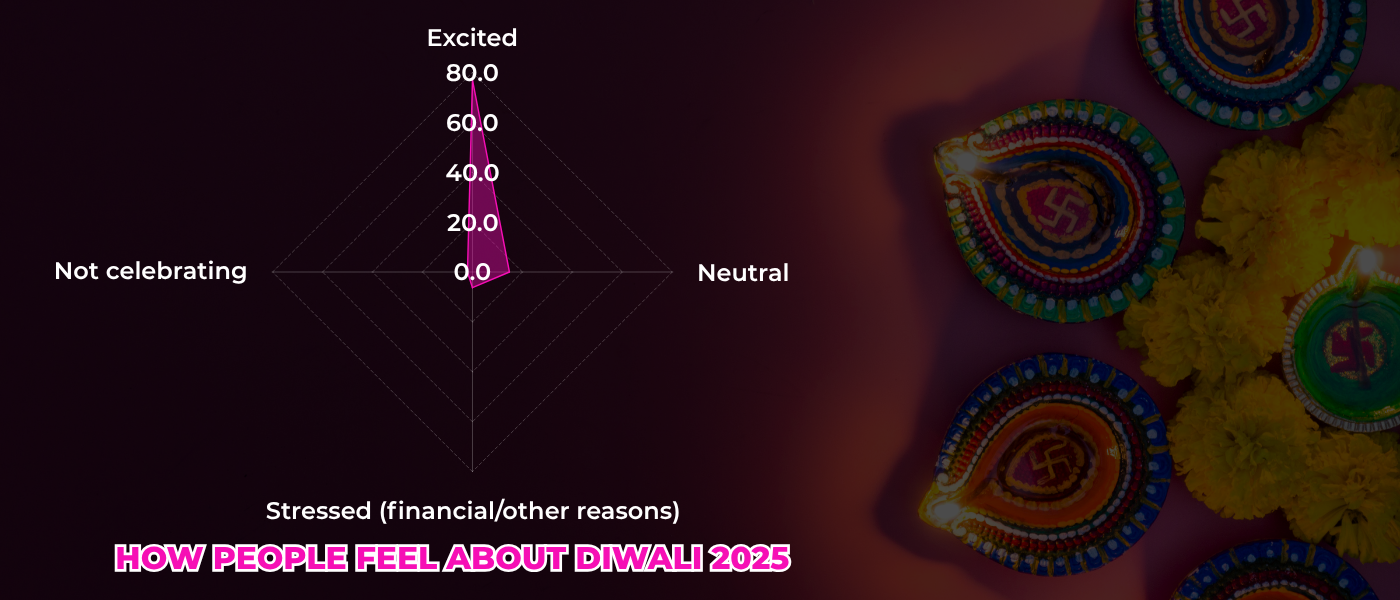
How India is celebrating Diwali 2025
Every year, Diwali ignites joy and togetherness across India - a moment when homes are illuminated and hearts reconnect. To understand how people are celebrating Diwali in 2025, Z.com Research surveyed 400 respondents across the country. The results reveal a nation eager to embrace the festive season with optimism, but also with a mindful awareness of financial realities and shifting consumer behaviors.
Emotional pulse: joy prevails, but awareness deepens

A striking 77% of respondents said they feel excited about Diwali this year, underscoring how powerfully the festival continues to uplift moods even amid broader economic concerns. While a small 6.3% reported feeling stressed - mainly due to financial or personal reasons - the overall sentiment is unmistakably bright.

What’s notable is that Diwali still outshines every other festival in emotional importance: 67.5% say it’s very important to them, and another 21.8% call it important. These figures suggest Diwali remains not just a celebration, but a reaffirmation of identity and continuity for Indian families.

Even after years of inflationary pressure, enthusiasm isn’t fading. 62.3% say they’re more excited than last year. This signals an emotional resilience - people are finding meaning beyond material scale, focusing on connection rather than consumption.
Spending trends: careful planning, not compromise

While spirits are high, the average Diwali shopper is clearly budgeting smarter. The majority (40%) plan to spend between ₹5,000–₹15,000, while 27.5% are keeping it under ₹5,000. This moderate spending pattern shows that people want to celebrate fully but within sustainable means.
High-spending households still exist - about 11.5% expect to go beyond ₹30,000 - but they form a small, concentrated segment, likely representing upper-middle-class urban consumers. Meanwhile, the preference for cash or savings (73%) indicates a strong aversion to debt-driven celebration. Only 0.5% resort to loans, while Buy Now Pay Later options (3.3%) remain marginal.

This points to a powerful cultural insight: Diwali spending is emotional, but deeply value-conscious. Consumers are willing to celebrate generously, yet still prioritize financial stability over showmanship.
The modern shopping rhythm: digital leads, local lingers

The timing and channels of purchase also reveal India’s evolving retail story. Nearly 46% of respondents shop 2–3 weeks before Diwali, showing a preference for organized, planned buying rather than impulsive last-minute splurges.

Digital commerce continues to dominate - 45.8% trust large e-commerce platforms like Amazon and Flipkart for Diwali shopping. Yet 26.5% still favor local markets, and 24% blend both online and offline - a pattern that highlights how “omnichannel loyalty” is shaping Indian consumption.
The data shows convenience and trust are equally valued. E-commerce offers reliability and selection, but local stores preserve the emotional touch - bargaining, sensory experience, and tradition - that online retail can’t replicate.
What drives the Diwali wallet: dressing joyfully, gifting meaningfully

Clothing and fashion claim the largest share of Diwali budgets (45.5%), reflecting how self-expression remains central to the festival’s visual culture. New outfits symbolize renewal and prosperity - an aesthetic ritual as much as a purchase.
Gifts for loved ones (23.3%) and sweets or festive food (14.3%) follow closely, underscoring Diwali’s role as a social bridge. Spending on gold and jewelry (10%) continues to represent traditional wealth preservation rather than indulgence, while home décor (7%) remains modest but meaningful - small touches that bring warmth and light to everyday life.
The deeper meaning: family above all

Beyond shopping and spending, the heart of Diwali beats in its emotional purpose. Nearly half (47%) say their main goal this Diwali is to strengthen family bonds. Another 34.3% simply want to enjoy festive food and sweets.
Only 4% associate Diwali with displaying social status, and 2% intend to travel - proving that the festival remains deeply rooted in home, kinship, and cultural continuity.
Meanwhile, 12.8% emphasize spiritual and religious practice, reflecting how Diwali continues to unite material joy with sacred ritual - a balance increasingly rare in modern festivals.
Inflation and the future: resilience over excess

When asked how they would adapt if inflation persists, 40.3% said they would reduce their overall budget, and 39% would focus on rituals while cutting luxuries. Another 14.8% would shift toward handmade or low-cost gifts. These responses show that the meaning of Diwali is evolving - people are ready to scale back materialism without losing the emotional and cultural essence of the celebration.
It’s not austerity; it’s adaptation. Indians are redefining prosperity through intentional celebration - where value, not volume, defines the festival spirit.
Powered by your voice with Z.com Research
These insights, gathered by Z.com Research, reflect how people across India continue to balance joy, responsibility, and tradition in meaningful ways. Every number tells a story - because every voice matters.
Z.com Research empowers users to share their opinions through short, engaging surveys and get rewarded for contributing to real insights about society, lifestyle, and culture. Whether you’re an existing panelist or new to the community, your participation helps shape stories like this.
Take more surveys, share your voice, and earn rewards - because Diwali may come once a year, but your opinions light up insights all year round.
Join Z.com Research today - where your voice truly makes a difference.












